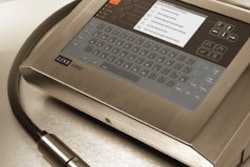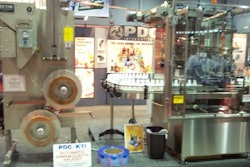Further, the Center’s mission is to design the infrastructure and develop the standards to create a universal, open network for identifying individual products and for tracking them as they flow through the global supply chain.
The Uniform Code Council (UCC) recognized that to achieve its goal, it would need to garner support from others. Accordingly, they enlisted Procter & Gamble and The Gillette Company. Together, the three organizations provided seed funding to establish the Center. In just two short years since the Center’s inception, 31 major companies from around the world have joined the Center to support its work. These companies, representing industries such as food, consumer goods, retail, transportation, and pharmaceuticals comprise the Center’s Board of Overseers, which governs the Center’s work. In addition, 38 companies focused on developing the software and manufacturing the hardware used in this system are members of the Center’s Technology Board. Currently, the Center has sister labs at the University of Cambridge in England and Adelaide University in Australia. Plans are under way to establish labs in China and Japan.
With a global staff of more than 50 scientists, engineers and graduate students, the Auto-ID Center is one of the most unique research programs anywhere in academia. The Center combines research and development simultaneously – joining global business leaders with the world’s leading scientists and engineers from around the world. This synergy enables the Center to research and test its technologies outside of the lab and in actual real world supply chain environments.
Leading the effort are: Kevin Ashton, Executive Director of the Auto-ID Center; Dick Cantwell, Chairman of the Auto-ID Center’s Board of Overseers, Vice President of Global Management for The Gillette Company; Dirk Heyman, Chairman of the Auto-ID Center’s Technology Board, Global Head of Sun Microsystems’ Life Science and Consumer Product Industries (Global Sales Operations); Professor Sanjay Sarma, Research Director and Founder, MIT, United States; Dr. Duncan McFarlane, Research Director, University of Cambridge, United Kingdom; Professor Peter Cole, Research Director, University of Adelaide, Australia.
About the Auto-ID Cente's EPC Network
The Auto-ID Center is home to a global research program focused on cutting-edge automatic identification
(auto-ID) technology. The Auto-ID Center’s vision is of a world where computers will be able to identify any object, anywhere, instantly. To accomplish that vision, the Center is designing the infrastructure and developing the standards to create a universal, open network for identifying individual products and for tracking them as they flow through the global supply chain. This will create a global system that will revolutionize how products are manufactured, tracked, sold, and recycled. The Center has identified five fundamental elements for this system:
- Electronic Product Code (EPC)
- ID System (Radio Frequency Readers and Tags)
- Object Name Service (ONS)
- Physical Markup Language (PML)
- Savant
Bringing these elements together within a supply chain could mean:
- Product authenticity – distributors and retailers will be able to confirm, with pinpoint accuracy, whether or not the goods on their shelves are authentic. They will have instant access to information indicating precisely when, where, and by whom a product was made.
- Product availability – every manufacturer will have true “produce-to-demand” capability, and will be able to eliminate excess inventory by drawing on the latest intelligence about purchasing trends. In addition, the EPC network has the potential to dramatically reduce out of stocks because, when a shelf gets low, the system can automatically alert staff to add more product. And, when the storeroom is running low, the distribution center or manufacturer can be alerted automatically to send additional inventory.
- Greater efficiencies – combining the benefits of produce-to-demand capability, theft reduction, and a reduction in manual stock keeping, the supply chain could recognize cost efficiencies in the range of hundreds of billions of dollars. According to the National Retail Security Survey conducted annually by the University of Florida, nearly 2 percent of total sales in the United States is lost each year due to “shrinkage” – employee and customer theft, vendor fraud and administrative error. The EPC network can reduce each of these contributors to shrinkage, bringing greater efficiencies into the global supply chain.
- Enhanced recycling – by coding a package as cardboard, aluminum, or plastic, waste management and recycling efforts could be greatly simplified and improved upon.
The Electronic Product Code (EPC) is the next generation of product identification similar to the UPC (Universal Product Code) or barcode. Like the bar code, the EPC is divided into numbers that identify the manufacturer, product, version and serial number. But, the EPC uses an extra set of digits to identify unique items. The EPC is the only information stored on the RFID tag’s microchip. This keeps the cost of the tag down and provides flexibility, since an infinite amount of dynamic data can be associated with the serial number in the database.
ID System; Radio Frequency Tags and Readers The EPC will be embedded in a special tag, the performance specifications for which are under design. Ideally these tags would be in the cost range of no more than a couple of cents. These tags will be applied during the manufacturing process. In turn, using radio waves, the tags will “communicate” their EPCs to Readers that are located in plants, warehouses, stores, and shelves. The readers will then pass EPCs along to a computer or local application system.
The Object Name Service (ONS) tells computer systems where to locate information on the Internet about any object carrying an EPC. ONS is similar to the Internet’s existing Domain Name System, which allows Internet routing computers to identify where the pages associated with a particular Web site are stored. The ONS takes the EPC code and returns a Web address or Uniform Resource Locator (URL) where all information about that object resides. This service makes it possible to store large amounts of information on the Internet rather than on the object or object-label.
The Physical Markup Language (PML) is a new standard “language” for describing physical objects. When finalized, it will be based on the widely accepted eXtensible Markup Language (XML). Together with the EPC and ONS, PML completes the fundamental components needed to automatically link information with physical products. The EPC identifies the product; the PML describes the product; and the ONS links them together. Standardizing these components will provide “universal connectivity” between objects in the physical world.
The Auto-ID Center has created software technology called Savant to manage and move information in a way that does not overload existing corporate and public networks. Savant uses a distributed architecture, meaning it runs on different computers distributed through an organization, rather than from one central computer. Savants are organized in a hierarchy and act as the nervous system of the new EPC network, managing the flow of information.
Testing the EPC Network in the field
In October 2001, the Auto-ID Center and a group of its sponsors launched a field test within a limited, real-life U.S. supply chain. The test, which is staged over several phases of complexity, is anticipated to run over a course of at least nine months and will involve over 20 companies. Auto-ID researchers, in conjunction with sponsors and partners, will use the test results to evaluate the performance of the technology and to evaluate applications for the EPC and related systems.
Phase I was focused on testing the software and involved tracking pallets of inventory from distribution centers around the U.S. to their final destination – the loading docks of a Sam’s Club in Tulsa, Oklahoma. The primary objective of Phase I was to evaluate the performance of various elements of the technology, including:
- Electronic Product Code (EPC) – which provides a unique ID to each inventory object, be it a pallet, case, or individual unit;
- Object Name Service (ONS) – which deciphers each EPC as a Web or server address (URL);
- Physical Markup Language (PML) – which describes the physical object associated with each EPC;
- Savant – which manages and moves information through the new EPC network.
Additional testing within Phase I involved adding some stress to the system and seeing if the elements of the technology can handle multiple entry points within this supply chain.
Phase II, which began in the summer of 2002, was focused on heightened stress testing of the system to see if the elements of the technology can handle greater volumes of inventory and the information associated with the inventory. Phase III will focus on testing the prototype cheap tags and readers, taking the system to the next level of complexity.
The Center is working with major business consulting groups to develop business case studies resulting from the various phases of the field test. Each phase will provide new learnings that will allow the Center and its sponsors to assess and plan for the next level and complexity of testing.
Once these technologies have been tested and refined in the field and outside of the lab, their potential is virtually unlimited. From significantly improving supply-chain management to addressing national security concerns, EPC could provide solutions.























